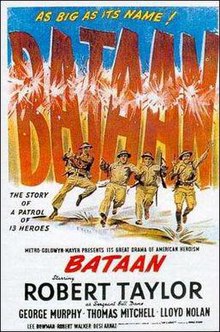Bataan (film): Difference between revisions
rv - consensus not yet reached on cat issue |
m image caption |
||
| Line 2: | Line 2: | ||
name = Bataan | |
name = Bataan | |
||
image = Bataan.jpeg | |
image = Bataan.jpeg | |
||
caption = Original Promotional Poster | |
|||
director = [[Tay Garnett]] | |
director = [[Tay Garnett]] | |
||
producer = [[Irving Starr]] | |
producer = [[Irving Starr]] | |
||
Revision as of 01:09, 2 January 2007
| Bataan | |
|---|---|
 Original Promotional Poster | |
| Directed by | Tay Garnett |
| Written by | Robert Hardy Andrews |
| Produced by | Irving Starr |
| Starring | Robert Taylor George Murphy Thomas Mitchell Robert Walker Desi Arnaz Lloyd Nolan |
| Cinematography | Sidney Wagner |
| Edited by | George White |
| Music by | Bronislau Kaper, Eric Zeisl |
| Distributed by | Metro-Goldwyn-Mayer; United States Office of War Information |
Release dates | |
Running time | 114 min. |
| Languages | English, Spanish, Latin |
Bataan is a 1943 propaganda film about the defense of the Bataan Peninsula, made by MGM. It was directed by Tay Garnett and produced by Irving Starr with Dore Schary as executive producer.
Historical setting of the film
The Battle of Bataan followed the Japanese December, 1941 invasion of the Philippines and lasted from January 1 to April 9, 1942. In this action, the unified United States and Philippine forces retreated from Manila onto the nearby, mountainous Bataan peninsula for a desperate last stand. There was hope that a relief would arrive, but none could be mustered. After 3 months of desperate fighting, the starving and malaria-ridden forces surrendered and were led on the infamous Bataan Death March.
Plot outline
Template:Spoilers In the film, the US Army is retreating. Thirteen men are chosen to blow up a bridge on the Bataan peninsula and keep the Japanese from advancing.
The film tells a classic military story of a group of soldiers thrown together to defend an undefendable target. A high bridge spans a ravine on the Bataan peninsula. After the retreat of the army and some civilians, this group sets up for its defense on a hillside. They successfully demolish the bridge, but their Captain is killed by a sniper in the process. Over the course of the movie, the 13 defenders die one by one, with one dying of malaria. The character played by Desi Arnaz and the pilot repair a broken airplane. Just before the plane is to take off, the pilot, played by future Senator George Murphy, is mortally wounded. In his last few moments of consciousness, he takes the plane off and intentionally crashes it into the bridge. The last few soldiers repel a massive frontal assault. Two more are killed by Japanese soldiers who are feigning death. In the final scene, the sergeant, played by Robert Taylor, heroically digs his own marked grave, stands within it, and fires his machine guns in a blaze of glory. As the final credits roll, he is still standing despite the converging forces. The final credits point to the bravery of soldiers like these as being responsible for victory in a series of battles listed.
Propaganda Film
Bataan is a film with an obvious message. It dehumanizes the Japanese soldiers while showing the Americans as heroic. Several scenes in the film, such as an inspirational speech near the end, and the last moments of the last survivor fighting to the bitter end, were intended to rally viewers for the war.
Notes
- The presence of a racially integrated fighting force prevented the film's showing in the United States' South.
- Scenes from the 1934 RKO film The Lost Patrol, directed by John Ford, were used in this film.
- Back to Bataan, the 1945 RKO film, directed by Edward Dmytryk with John Wayne, returns to the same setting and theme.
External links
- Bataan at the Internet Movie Database
